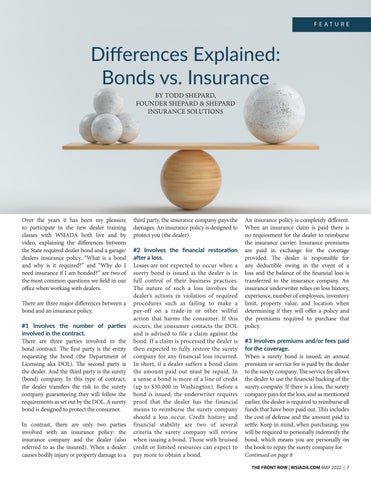FEATURE
Differences Explained: Bonds vs. Insurance BY TODD SHEPARD, FOUNDER SHEPARD & SHEPARD INSURANCE SOLUTIONS
Over the years it has been my pleasure to participate in the new dealer training classes with WSIADA both live and by video, explaining the differences between the State required dealer bond and a garage/ dealers insurance policy. “What is a bond and why is it required?” and “Why do I need insurance if I am bonded?” are two of the most common questions we field in our office when working with dealers. There are three major differences between a bond and an insurance policy. #1 Involves the number of parties involved in the contract. There are three parties involved in the bond contract. The first party is the entity requesting the bond (the Department of Licensing aka DOL). The second party is the dealer. And the third party is the surety (bond) company. In this type of contract, the dealer transfers the risk to the surety company guaranteeing they will follow the requirements as set out by the DOL. A surety bond is designed to protect the consumer. In contrast, there are only two parties involved with an insurance policy: the insurance company and the dealer (also referred to as the insured). When a dealer causes bodily injury or property damage to a
third party, the insurance company pays the damages. An insurance policy is designed to protect you (the dealer). #2 Involves the financial restoration after a loss. Losses are not expected to occur when a surety bond is issued as the dealer is in full control of their business practices. The nature of such a loss involves the dealer’s actions in violation of required procedures such as failing to make a pay-off on a trade-in or other willful action that harms the consumer. If this occurs, the consumer contacts the DOL and is advised to file a claim against the bond. If a claim is processed the dealer is then expected to fully restore the surety company for any financial loss incurred. In short, if a dealer suffers a bond claim the amount paid out must be repaid. In a sense a bond is more of a line of credit (up to $30,000 in Washington). Before a bond is issued, the underwriter requires proof that the dealer has the financial means to reimburse the surety company should a loss occur. Credit history and financial stability are two of several criteria the surety company will review when issuing a bond. Those with bruised credit or limited resources can expect to pay more to obtain a bond.
An insurance policy is completely different. When an insurance claim is paid there is no requirement for the dealer to reimburse the insurance carrier. Insurance premiums are paid in exchange for the coverage provided. The dealer is responsible for any deductible owing in the event of a loss and the balance of the financial loss is transferred to the insurance company. An insurance underwriter relies on loss history, experience, number of employees, inventory limit, property value, and location when determining if they will offer a policy and the premiums required to purchase that policy. #3 Involves premiums and/or fees paid for the coverage. When a surety bond is issued, an annual premium or service fee is paid by the dealer to the surety company. The service fee allows the dealer to use the financial backing of the surety company. If there is a loss, the surety company pays for the loss, and as mentioned earlier, the dealer is required to reimburse all funds that have been paid out. This includes the cost of defense and the amount paid to settle. Keep in mind, when purchasing, you will be required to personally indemnify the bond, which means you are personally on the hook to repay the surety company for Continued on page 8 THE FRONT ROW | WSIADA.COM MAY 2022 | 7






